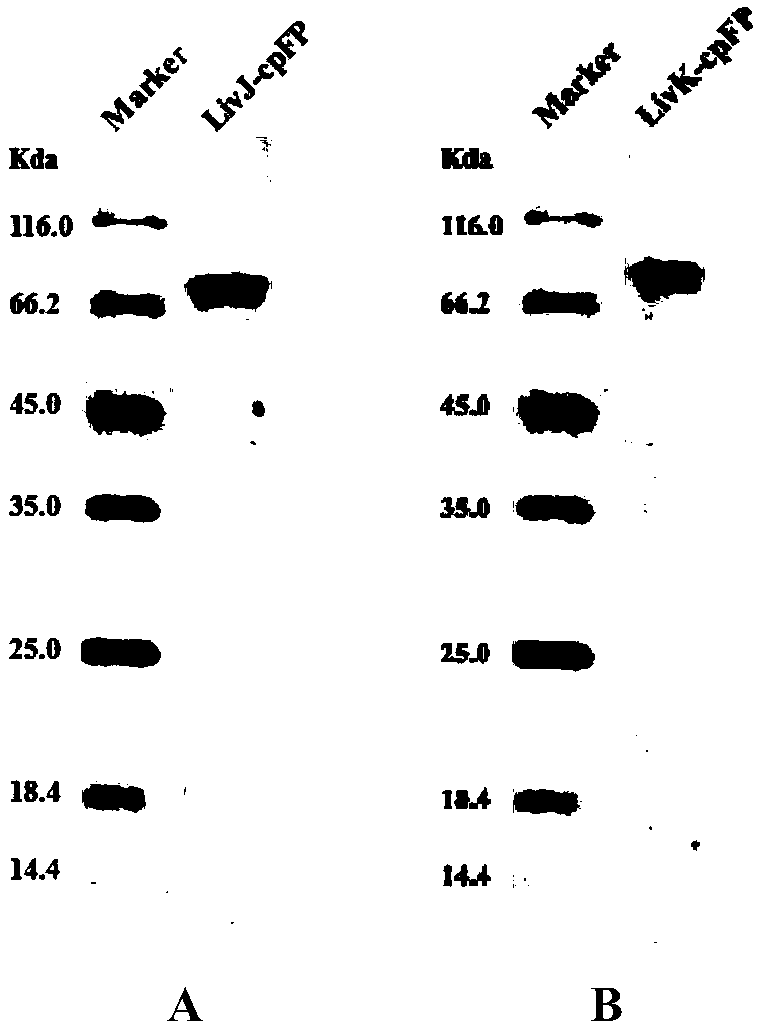Branched chain amino acid fluorescent probe and application thereof
A branched-chain amino acid, fluorescent probe technology, applied in the field of fluorescent proteins, can solve problems such as failure to meet monitoring requirements
- Summary
- Abstract
- Description
- Claims
- Application Information
AI Technical Summary
Problems solved by technology
Method used
Image
Examples
Embodiment 1
[0184] Construction of pRSETb-LivJ and pRSETb-LivK plasmids
[0185] The LivJ and LivK genes in E. coli genes were amplified by PCR. The PCR product of LivJ was recovered after gel electrophoresis and digested with BamHI and HindIII; the PCR product of LivK was recovered after gel electrophoresis and digested with EcoRI and HindIII. Carry out the corresponding double digestion of the vector. After ligation with T4 DNA ligase, the ligation product was transformed into MachI, and the transformed MachI was spread on LB plates (ampicillin 100ug / mL), and cultured at 37°C overnight. After plasmid extraction of the growing MachI transformants, PCR identification was performed. After the positive plasmid is correctly sequenced, the subsequent plasmid construction is carried out.
[0186] Construction and detection of pRSETb-LivJ-cpYFP, pRSETb-LivK-cpYFP fluorescent probes with different insertion sites
[0187] In this example, we used pRSETb-LivJ as the base plasmid to select 11...
Embodiment 2
[0194] Design, Construction and Detection of Branched-chain Amino Acid Fluorescent Probes Based on cpBFP
[0195] According to the method in Example 1, cpYFP was replaced by blue fluorescent protein cpBFP, and fused into branched-chain amino acid binding protein and leucine-binding protein to construct branched-chain amino acid blue fluorescent protein fluorescent probe and leucine blue fluorescence respectively Protein fluorescent probes. The result is as image 3 As shown, the fluorescence detection results showed that 326 / 327 and 327 / 328 of the branched-chain amino acid fluorescent probes responded more than 3 times to branched-chain amino acids; 328 / 329 of the leucine fluorescent probes responded more than 1.5 times to leucine , 329 / 330.
Embodiment 3
[0197] Design, construction and detection of branched-chain amino acid fluorescent probes based on cpmApple
[0198] According to the method in Example 1, cpYFP was replaced by apple red fluorescent protein cpmApple, and fused into branched-chain amino acid binding protein and leucine-binding protein to construct branched-chain amino acid red fluorescent protein fluorescent probe and leucine red fluorescent protein fluorescent probe respectively. probe, the result is as Figure 4 As shown, the fluorescent detection results showed that 326 / 327, 327 / 328 of the branched-chain amino acid fluorescent probes responded more than 3 times to branched-chain amino acids; 328 / 329, 329 of the leucine fluorescent probes responded more than 1.5 times to leucine. / 330.
[0199] The results of Examples 1-3 show that the linker region 325-329 of the branched-chain amino acid binding protein is suitable for fusion of cpFP fluorescent protein to obtain a fusion fluorescent protein branched-chain...
PUM
 Login to View More
Login to View More Abstract
Description
Claims
Application Information
 Login to View More
Login to View More - R&D
- Intellectual Property
- Life Sciences
- Materials
- Tech Scout
- Unparalleled Data Quality
- Higher Quality Content
- 60% Fewer Hallucinations
Browse by: Latest US Patents, China's latest patents, Technical Efficacy Thesaurus, Application Domain, Technology Topic, Popular Technical Reports.
© 2025 PatSnap. All rights reserved.Legal|Privacy policy|Modern Slavery Act Transparency Statement|Sitemap|About US| Contact US: help@patsnap.com



